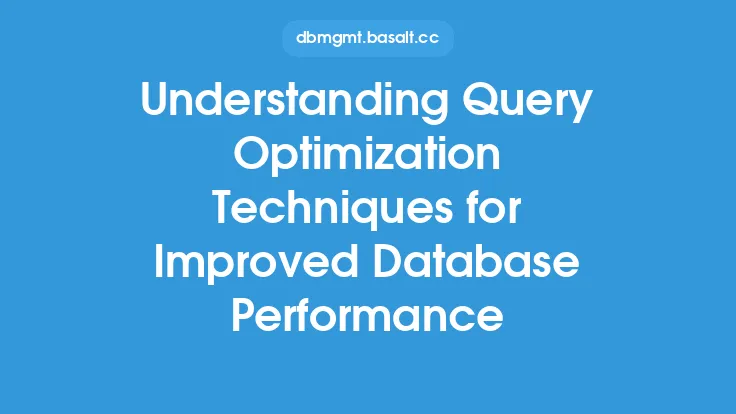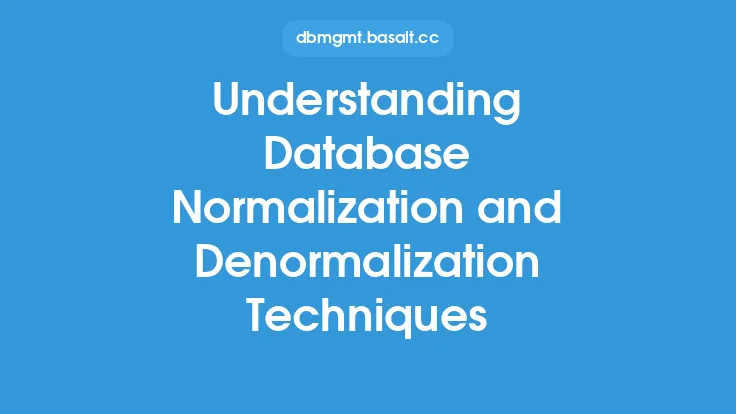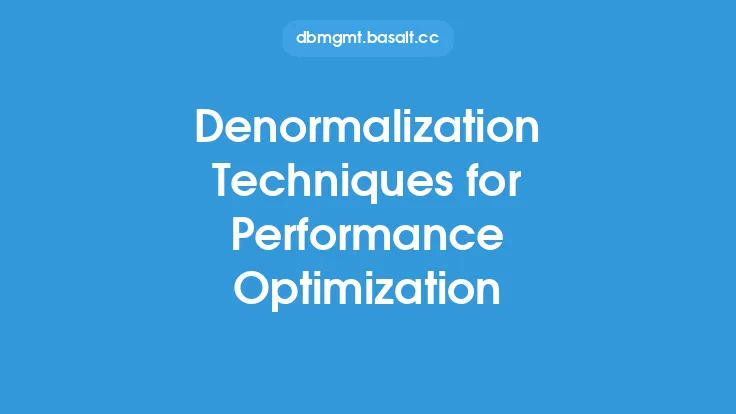When it comes to database design, one of the key considerations is how to structure data to achieve optimal performance. Normalization is a widely accepted principle that aims to minimize data redundancy and dependency by organizing data into separate tables. However, in certain situations, denormalization techniques can be employed to improve database performance. Denormalization involves intentionally deviating from the principles of normalization to achieve specific goals, such as reducing the number of joins required to retrieve data or improving data retrieval speed.
Introduction to Denormalization Techniques
Denormalization techniques involve deliberately duplicating data or grouping related data together to reduce the number of database operations required to retrieve or manipulate data. This approach can be beneficial in situations where data is frequently accessed or where complex queries are commonly executed. By denormalizing data, database administrators can reduce the overhead associated with joins, subqueries, and other database operations, resulting in improved performance and faster data retrieval.
Types of Denormalization Techniques
There are several types of denormalization techniques that can be employed, each with its own strengths and weaknesses. Some common techniques include:
- Pre-aggregation: This involves pre-calculating and storing aggregated values, such as sums or averages, to reduce the need for complex calculations at runtime.
- Pre-joining: This involves storing data from multiple tables in a single table to reduce the need for joins.
- Data duplication: This involves duplicating data from one table to another to reduce the need for subqueries or joins.
- Data grouping: This involves grouping related data together to reduce the number of database operations required to retrieve or manipulate data.
Benefits of Denormalization Techniques
Denormalization techniques can offer several benefits, including:
- Improved data retrieval speed: By reducing the number of database operations required to retrieve data, denormalization techniques can improve data retrieval speed and reduce latency.
- Reduced overhead: Denormalization techniques can reduce the overhead associated with joins, subqueries, and other database operations, resulting in improved performance and reduced resource utilization.
- Simplified queries: Denormalization techniques can simplify complex queries by reducing the number of tables that need to be accessed or joined.
Challenges and Considerations
While denormalization techniques can offer several benefits, they also present several challenges and considerations. Some of the key challenges and considerations include:
- Data consistency: Denormalization techniques can make it more difficult to maintain data consistency, as changes to data may need to be propagated across multiple tables.
- Data redundancy: Denormalization techniques can result in data redundancy, which can lead to inconsistencies and errors if not properly managed.
- Storage requirements: Denormalization techniques can increase storage requirements, as duplicate data may need to be stored in multiple tables.
Best Practices for Implementing Denormalization Techniques
To ensure that denormalization techniques are implemented effectively, several best practices should be followed. Some of the key best practices include:
- Carefully evaluate the trade-offs: Denormalization techniques can offer several benefits, but they also present several challenges and considerations. Carefully evaluate the trade-offs and ensure that the benefits outweigh the costs.
- Monitor performance: Monitor database performance and adjust denormalization techniques as needed to ensure optimal performance.
- Maintain data consistency: Implement mechanisms to maintain data consistency and ensure that changes to data are properly propagated across multiple tables.
- Optimize storage: Optimize storage requirements by minimizing data redundancy and using efficient storage mechanisms.
Common Use Cases for Denormalization Techniques
Denormalization techniques are commonly used in a variety of scenarios, including:
- Data warehousing: Denormalization techniques are often used in data warehousing to improve query performance and reduce the complexity of queries.
- Real-time analytics: Denormalization techniques are often used in real-time analytics to improve data retrieval speed and reduce latency.
- High-traffic websites: Denormalization techniques are often used in high-traffic websites to improve performance and reduce the overhead associated with database operations.
Tools and Technologies for Denormalization
Several tools and technologies are available to support denormalization techniques, including:
- Database management systems: Most database management systems, such as MySQL and Oracle, support denormalization techniques and provide mechanisms for implementing pre-aggregation, pre-joining, and data duplication.
- Data warehousing tools: Data warehousing tools, such as Amazon Redshift and Google BigQuery, provide mechanisms for implementing denormalization techniques and optimizing query performance.
- NoSQL databases: NoSQL databases, such as MongoDB and Cassandra, are designed to support denormalization techniques and provide mechanisms for storing and retrieving denormalized data.
Conclusion
Denormalization techniques can be a powerful tool for improving database performance and reducing the complexity of queries. By carefully evaluating the trade-offs and following best practices, database administrators can effectively implement denormalization techniques to achieve optimal performance and improve data retrieval speed. While denormalization techniques present several challenges and considerations, they can offer several benefits, including improved data retrieval speed, reduced overhead, and simplified queries. As database systems continue to evolve, denormalization techniques will remain an important consideration for database administrators seeking to optimize performance and improve data retrieval speed.





